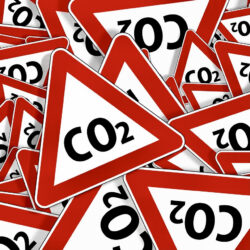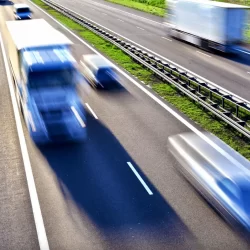Finding the optimal balance between costs and carbon emissions

There are countless ways you can reduce carbon emissions in your supply chain. But which measures deliver the greatest results? And do they outweigh the costs of implementing them? During a webinar by Supply Chain Media and software vendor AIMMS, it was demonstrated that supply chain network design provides answers to these questions. “It helps you find the sweet spot between cost, profitability, service levels and emissions.”
By Marcel te Lindert
What is the optimal location for a new steel plant in Brazil? Facundo Olivero, supply chain consultant at AIMMS, could answer that question. First, he presented a map visualizing the design of a supply chain optimized for cost alone. It showed that the best location would be inland in northern Brazil. Then he displayed the same map, but with a design optimized for both cost and CO2 emissions. The steel plant should still be located in northern Brazil, but a little closer to the coast.
“This is only a slight shift in location, but the impact on carbon emissions is huge,” he explained. “In the second scenario, the plant is located as close as possible to the main raw materials supplier. This virtually eliminates emissions from raw material transportation. Based on costs alone, it would make sense to choose the first location. That location is optimal now, but not in a few years’ time when you have to start paying for carbon emissions.”
Analysing and visualizing scenarios
AIMMS, based in the Dutch city of Haarlem, specializes in situations such as these. The company develops software for supply chain network design. “We enable companies to make a digital twin of their supply chain, so that they can analyse and visualize various scenarios. The visualization aspect is particularly important. You can see how the supply chain changes on the screen as you model different scenarios,” stated Zoë Kokje Schouten, business director of supply chain solutions at AIMMS.
Supply chain network design reveals the optimal supply chain set-up based on the factors the company considers important. These usually revolve around cost, profitability and service levels, but the carbon footprint can also be a factor, according to AIMSS. “You can optimize the design based on just one of the factors, or all of them simultaneously. Supply chain network design helps you make the right trade-off and find the sweet spot between costs, profitability, service levels and emissions,” said Kokje Schouten.
Reducing rather than offsetting
Needless to say, many businesses have had sustainability on the agenda for some time, but they are now under increasing pressure to improve the sustainability of their own supply chains. “As a first step, many companies offset their own carbon emissions by investing in CO2 reduction projects elsewhere in the world. But companies can no longer avoid reducing their own emissions as well – not only because customers and employees demand it, but also because carbon emissions will increasingly have a financial impact due to legislation, tax breaks and fines.”
‘Decarbonizing’ the supply chain starts with a baseline measurement. What does the supply chain currently look like, and how big is the carbon footprint? It can take a few weeks to a month to establish this baseline model, according to Olivero. “Then it’s a matter of analysing where those CO2 emissions come from. Are they Scope 1 emissions, in other words emissions directly caused by your own factories and distribution centres? Or are they indirect emissions caused by the energy you purchase (Scope 2 emissions), for example, or by the raw materials sourced from suppliers (Scope 3 emissions)? The vast majority of emissions are generated upstream in the supply chain.”
Trade-off between costs and emissions
The second step is to model scenarios aimed at reducing emissions. What if the raw materials are sourced from a different supplier? Or what if a distribution centre is closed down, or if a different mode of transport is used? “We can analyse the effect of every measure. It’s important to know what each measure costs and how it impacts on emissions,” explained Olivero. “Even the smallest change can have an impact on the whole supply chain. If you try to calculate that with a spreadsheet, it will take forever. A supply chain network design tool reveals the impact in a matter of minutes.”
In particular, it can be a challenge to find the sweet spot between cost, profitability, service levels and emissions. “If you want to weigh up the costs against the emissions, you can enter how much you currently pay – or will soon have to pay – for each tonne of CO2 you emit. Some companies generate graphs that plot the supply chain costs against the carbon emissions,” Olivero continued. This helps them to choose their position in the matrix and make the right trade-off. “Then it’s just a matter of determining what measures are needed to reach that position.”
Counterproductive measures
Companies have then arrived at the third and final step: determining their sustainability strategy. Which measures should be implemented, and when and where in the supply chain? Should the focus be on improving the load factor, or using alternative modalities? Should production be moved closer to the market, or are longer lead times acceptable? Olivero: “It’s not only about the carbon reduction potential of the possible measures, but also about the necessary level of investment. And many companies forget to think about how all the measures are interlinked. Some measures might complement each other and lead to extra CO2 reductions, but there may also be measures that are counterproductive.”
Although many companies are currently focusing on their carbon footprint, it doesn’t have to stop there. According to AIMMS, supply chain network design can also be used to optimize energy consumption, water consumption and recycling rates, for example, and the software vendor is further developing its own tool with these issues in mind. As an example, Kokje Schouten mentioned the use of climate data to uncover supply chain risks. “Take the current drought in Spain, which could have a major impact on the supply chain in that region. Understanding the risks helps companies to implement the right measures and prevent disruptions. We will add functionality for this in the near future.”










